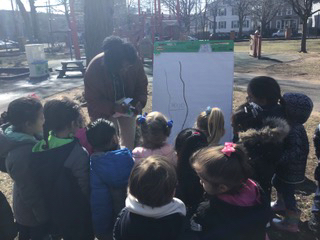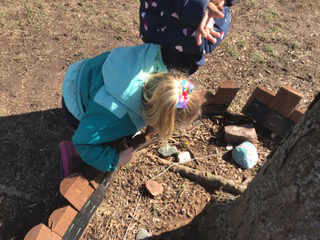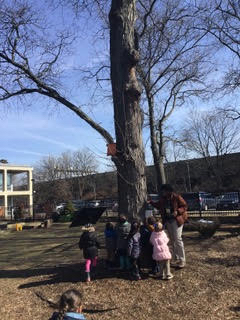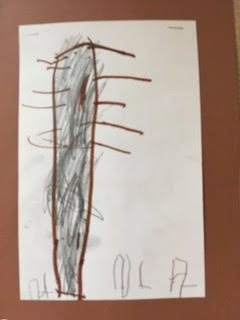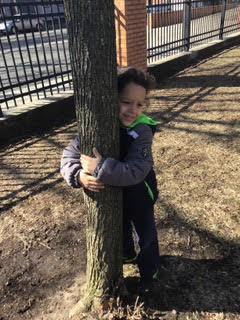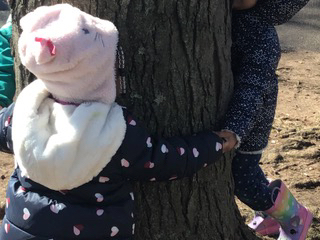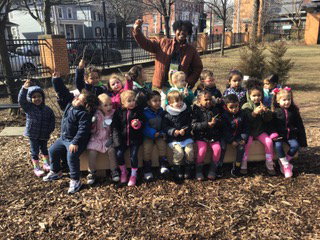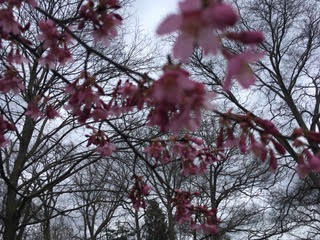Hug a Tree: A Theme for STEAM Learning
Seedlings Facilitator Julie Peterman took her students out to look at trees for a meaningful learning experience.
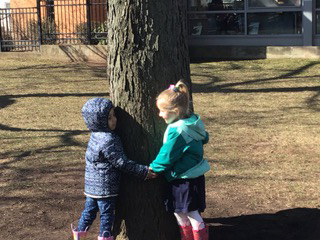
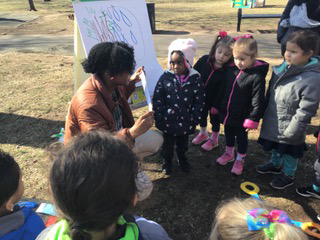
One warm late winter morning, Julie Peterman’s 3-year old class at Conte West Magnet School to were introduced to Nyree Hodges, an educator at Common Ground Urban Farm and Environmental Education Center. Nyree brought the “Meet a Tree” schoolyard activity to the children so they could explore in Conte West’s schoolgrounds. We will let her take it from here.
I am lucky enough to have huge windows in my classroom that face out to the yard. We observe the trees as they have change from fall to winter. We see them wave in the wind. We watch squirrels climb up their trunks and birds land on their branches. Children see large old mature trees and small newly planted trees. Meeting Nyree was a natural progression for using trees as a framework for integrated STEAM learning.
-
Assessing Prior Knowledge
We gathered ourselves under one of our oldest and largest trees. Nyree helped the children share their ideas and knowledge about trees. She represented their ideas by drawing images on a large chart. The children shared a mixture of great background knowledge (tree have roots, trees have leaves) and some not so accurate ideas (trees make rain).
-
Building Observation Skills Through Play
Nyree then asked one child at a time to explore the tree with their five senses and share their thoughts: how it looks, how it feels, how it smells, how it sounds. Then all the children ran around the yard, tree to tree to explore with their senses. What a joyful time observing the children stop at a tree, focus on it, touch it and smell it, and then run on to the next tree.
We gathered back together with Nyree’s special call, “Caw, caw,” and she invited each child to then go find a stick. Each child hunted for and collected one stick. They were instructed to study and describe their stick. After a time all the sticks were dropped in a pile. Almost every child later recognized and claimed the stick they had found. Even the next day several children were able to find and reclaim the stick they had met!
We then went to the log benches in our habitat to explore a cut down tree. The children shared about the difference between the inside and outside of the trees, how different they looked, felt and smelled. The children became more interested in laying on the logs, and playing with their sticks! Play - the work of children! -
Balancing, Counting, Measuring
Through play, children also built science, math, vocabulary and literacy skills. They worked on balancing their sticks on the trellis. They compared the size and shape of their sticks. They scraped the ground, made shapes and dug in the dirt. They collected and counted more sticks. We tried to fit our hands around the trunk, then our arms and then found a tree that needed three sets of arms to measure all the way around. One child found a stick in the shape of the first letter of his name and he was so excited he had to share it with everyone!
-
Feasibility: The Field Trip Can Come to You!
Our field study allowed us to remain right on our own school grounds. We are very lucky to have an abundance of amazing and diverse trees on our school property. Common Ground Education Center has a wonderful array of programs that they bring right to your school.
Learn more about Common Ground by clicking the leaf symbol to the left of this text.
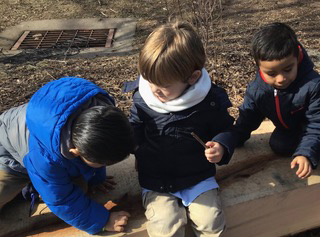
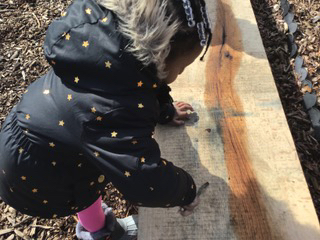
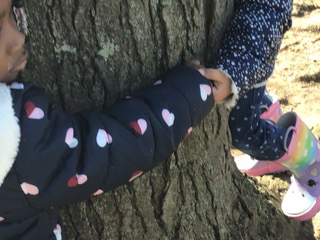
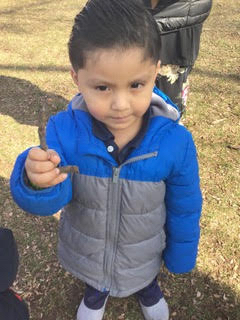
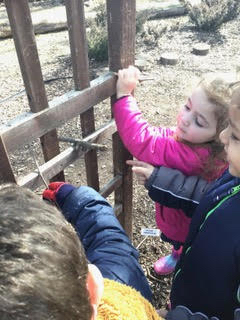
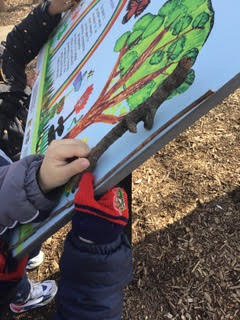
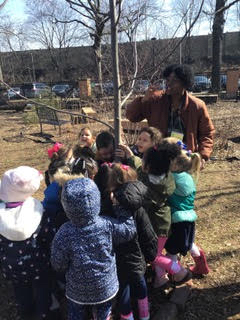
Julie Peterman is a K/1 facilitator with Seedlings. She has spent more than 35 years teaching. Students and their developmental needs are at the center of what she does.
More from In My Classroom
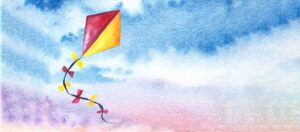
Kite Making Teaches Seasons, Weather and Other Targeted Science Skills
Jen Wilson’s kindergarten class studied and built kites to study weather and motion through inquiry, observation, research, and design. Students also learned imported social-emotional skills like overcoming frustration, perseverance, quelling anxious feelings.

A Lump Of Clay: A Language Bridge For Pre-Schoolers
Clay is an open-ended medium that allows children to show their thinking.

Integrating Natural Materials in the Classroom
Julie Peterman’s attempt at creating a more natural setting in my public school classroom had her hauling bags of birch bark, sticks, stones, pine cones, seed pods, and seashells.
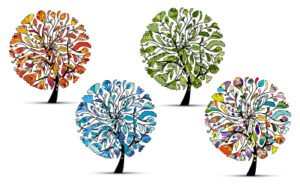
Simply Teach: Bringing Seedlings Workshop Concepts Back to the Classroom
“Often, it’s simpler than we first think to bring these meaningful connections and engaging activities within our existing curriculum,” says Seedlings alum and Fellow Jen Wilson on integrating hands-on learning into her classroom.

A Labor Of Love: The First Weeks Teaching Pre-K3, SEC Fellow Julie Peterman
The first days of Pre K 3 are what we lovingly call the “Cryfest.” Working on helping the children build secure attachments to their new caregivers takes time.
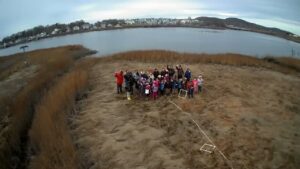
Learning about Science and Nature through Community Connections
Conte West Students Learn about Science and Nature through Field Work and Community Connections. 2017-18 Seedlings Fellow Diane Huot, a first grade teacher in New Haven, has incorporated field trips to Quinnipiac Meadows Reserve into her class’ study of habitats and organisms with her class.
One warm late winter morning, Julie Peterman took her 3-year old class at Conte West Magnet School to Common Ground Urban Farm and Environmental Education Center where they were introduced to Nyree Hodges and her program “Meet a Tree.” We will let her take it from here.
I am lucky enough to have huge windows in my classroom that face out to the yard. We observe the trees as they have change from fall to winter. We see them wave in the wind. We watch squirrels climb up their trunks and birds land on their branches. Childreen see large old mature trees and small newly planted trees. Meeting Nyree and “her” trees was the next step in learning about trees and trees provided a framework for integrated STEAM learning. Some highlights and take-aways from our trip:
On this beautiful morning we gathered ourselves under one of our oldest and largest trees. Nyree helped the children share their ideas and knowledge about trees. She represented their ideas by drawing images on a large chart. The children shared a mixture of great background knowledge (tree have roots, trees have leaves) and some not so accurate ideas (trees make rain).
Nyree then asked one child at a time to explore the tree with their five senses and share their thoughts: how it looks, how it feels, how it smells, how it sounds. Then all the children ran around the yard, tree to tree to explore with their senses. What a joyful time observing the children stop at a tree, focus on it, touch it and smell it, and then run on to the next tree.
We gathered back together with Nyree’s special call, “Caw, caw,” and she invited each child to then go find a stick. Each child hunted for and collected one stick. They were instructed to study and describe their stick. After a time all the sticks were dropped in a pile. Almost every child later recognized and claimed the stick they had found. Even the next day several children were able to find and reclaim the stick they had met!
We then went to the log benches in our habitat to explore a cut down tree. The children shared about the difference between the inside and outside of the trees, how different they looked, felt and smelled. The children became more interested in laying on the logs, and playing with their sticks! Play – the work of children!
Observing the independent play of the children was amazing. They worked on balancing their sticks on the trellis. They compared the size and shape of their sticks. They scraped the ground, made shapes and dug in the dirt. They collected and counted more sticks. We tried to fit our hands around the trunk, then our arms and then found a tree that needed three sets of arms to measure all the way around. One child found a stick in the shape of the first letter of his name and he was so excited he had to share it with everyone!
Our field study allowed us to remain right on our own school grounds. We are very lucky to have an abundance of amazing and diverse trees on our school property.
As winter has turned to spring, I watch with wonder as my tree friends wake up from their winter slumber and begin to grow up and out. I delight as buds turn to flowers and soon will grow leaves.
Now that the world is on hold I mourn losing the opportunity to watch the trees in our play yard come back to life with my students. We would have adopted a branch on a few trees and watched and discussed and recorded the reawakening. We are socially isolated, but spring continues to happen all around us. This year I cherish the time to watch the process on my own. I will encourage my students to get out and do the same. And the rhythm of nature and the promise of that consistency of a tree will bring me comfort in this new and ever changing world.
